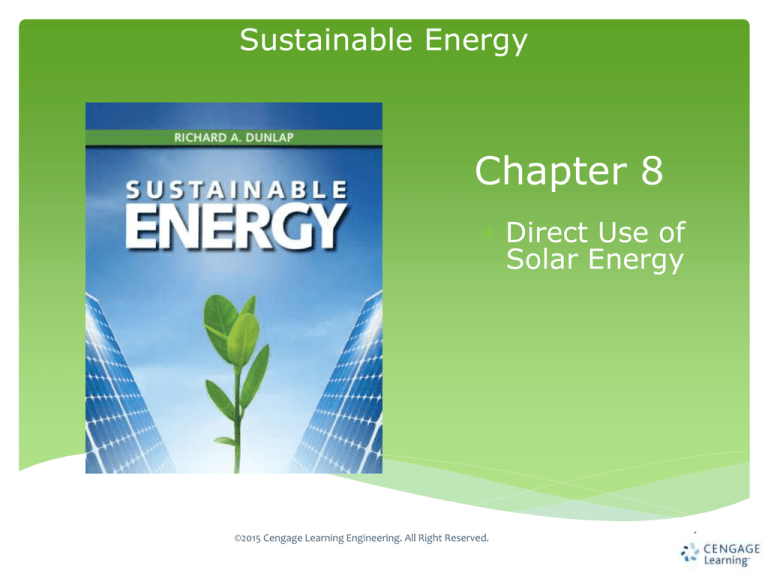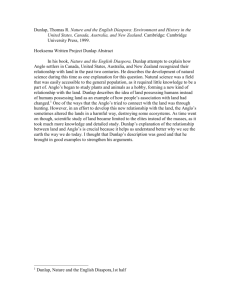
Sustainable Energy
Chapter 8
Direct Use of
Solar Energy
©2015 Cengage Learning Engineering. All Right Reserved.
1
Sustainable Energy
Dunlap
Learning Objectives
●
●
●
●
●
●
●
●
●
The energy content and properties of the sunlight incident
on the earth.
The mechanisms for heat transfer.
Conductive heat transfer through materials and the use of
R-values.
Radiative heat transfer from surfaces.
The design and operation of a thermal solar collector.
The energy requirements for residential space heating.
The description of heating needs on the basis of degree
days.
The storage of thermal energy and the heat capacity of
solids.
The use of passive solar heating techniques as a
component of residential heating needs.
©2015 Cengage Learning Engineering. All Right Reserved.
2
Sustainable Energy
Dunlap
The solar constant
The solar constant is the power density of the sun's
radiation at a distance of the earth's orbit.
The solar constant is calculated as the total power
radiated by the sun divided by the surface area of a
sphere at the earth's orbit
The solar radiation outside the earth's atmosphere is
approximated by a black body radiation curve at 6000 K.
©2015 Cengage Learning Engineering. All Right Reserved.
3
Sustainable Energy
Dunlap
Absorption in the atmosphere
The earth's atmosphere reflects and absorbs solar radiation.
Certain molecular species in the atmosphere absorb at specific
wavelengths.
©2015 Cengage Learning Engineering. All Right Reserved.
4
Sustainable Energy
Dunlap
Average insolation
The total radiation on the earth solar constant times the
cross sectional area of the earth's disk
About half of this is absorbed or reflected by the earth's
atmosphere.
The average (horizontal) insolation is the incident radiation
arriving at the earth's surface divided by the total area of
the earth
©2015 Cengage Learning Engineering. All Right Reserved.
5
Sustainable Energy
Dunlap
Distribution of insolation
The insolation at a given point on the earth's
surface depends on factors such as
• The time of day
• The day of the year
• The latitude
The average insolation at a particular location
also depends on average weather conditions
©2015 Cengage Learning Engineering. All Right Reserved.
6
Sustainable Energy
Dunlap
Average insolation in the United States
Yearly 24 hour average insolation in the United States
©2015 Cengage Learning Engineering. All Right Reserved.
7
Sustainable Energy
Dunlap
Heat transfer
In order to understand the design of solar collectors we
need to understand how heat is transported.
Heat transport can be by
• Conduction
• Convection
• Radiation
©2015 Cengage Learning Engineering. All Right Reserved.
8
Sustainable Energy
Dunlap
Conduction
Heat transfer by conduction through a piece of material
depends on
• The temperature difference across the material (Th - Tc)
• The cross sectional are of the material A
• The thickness of the material l
• The thermal conductivity of the material k
©2015 Cengage Learning Engineering. All Right Reserved.
9
Sustainable Energy
Dunlap
Units
In British units
T in °F
A in ft2
l in inches
k in (Btu•in)/(h•ft2•°F)
P in Btu/h
©2015 Cengage Learning Engineering. All Right Reserved.
10
Sustainable Energy
Dunlap
Metric (SI) units
T in °C or K
A in m2
l in cm
k in (W•cm)/(m2•°C)
P is in W
©2015 Cengage Learning Engineering. All Right Reserved.
11
Sustainable Energy
Dunlap
R-values
Power per unit area is expressed as
where R = l/k and has units
British system (h•ft2•°F)/Btu
SI system (m2•°C)/W
©2015 Cengage Learning Engineering. All Right Reserved.
12
Sustainable Energy
Dunlap
Thermal conductivities of some
common building materials
©2015 Cengage Learning Engineering. All Right Reserved.
13
Sustainable Energy
Dunlap
Addition of R-values
R-values are additive for materials (i.e. walls)
comprised of several layers
©2015 Cengage Learning Engineering. All Right Reserved.
14
Sustainable Energy
Dunlap
Convection
Convection is the transport of thermal energy
by air movement.
This is a very complex problem and is not
considered quantitatively in this course.
©2015 Cengage Learning Engineering. All Right Reserved.
15
Sustainable Energy
Dunlap
Radiation
All objects at a temperature above absolute zero radiate
energy according to the Stefan-Boltzmann law. For a
perfect black body the total radiation is
For an object that is not a perfect black body
Most common materials have emissivities of around ε=0.9.
©2015 Cengage Learning Engineering. All Right Reserved.
16
Sustainable Energy
Dunlap
Wavelength dependence of black body
radiation
©2015 Cengage Learning Engineering. All Right Reserved.
17
Sustainable Energy
Dunlap
Solar space heating
Solar space heating may be accomplished using
• an active system consisting of a solar collector
which heats a working fluid which is circulated
to heat a building
• a passive system which heats the interior of the
building directly as a result of building design
and placement
©2015 Cengage Learning Engineering. All Right Reserved.
18
Sustainable Energy
Dunlap
Solar collectors
Typical flat plate solar collector
©2015 Cengage Learning Engineering. All Right Reserved.
19
Sustainable Energy
Dunlap
Solar collector design
©2015 Cengage Learning Engineering. All Right Reserved.
20
Sustainable Energy
Dunlap
Solar collector design
Features of a solar collector
•
•
•
•
insulated box
transparent cover
absorbing plate
pipes to carry working fluid
©2015 Cengage Learning Engineering. All Right Reserved.
21
Sustainable Energy
Dunlap
Principles of operation
Solar radiation enters through the transparent cover and is
absorbed by the plate which heats and transfers heat
to the working fluid.
Absorbed radiation is at short wavelength characteristic of the
black body temperature of the sun (about 500 nm).
Energy re-irradiated from the plate is long wavelength
characteristic of a black body at the operating
temperature of the collector (about 8000 nm).
©2015 Cengage Learning Engineering. All Right Reserved.
22
Sustainable Energy
Dunlap
Minimizing energy loss
Energy loss is minimized by two mechanisms
• conduction is minimized by insulation behind
the plate
• radiative losses are minimized if the
transparent cover is transparent to short
wavelength radiation and opaque to long
wavelength radiation
©2015 Cengage Learning Engineering. All Right Reserved.
23
Sustainable Energy
Dunlap
Characteristics of a suitable glazing material
©2015 Cengage Learning Engineering. All Right Reserved.
24
Sustainable Energy
Dunlap
Availability of solar energy
Available solar energy per unit collector area
depends on
• Geographic location
• Time of year
• Orientation of the collector
©2015 Cengage Learning Engineering. All Right Reserved.
25
Sustainable Energy
Dunlap
Collector orientations
• horizontal
• vertical (facing south in Northern Hemisphere)
• tilted at optimal angle (facing south in
Northern Hemisphere)
• tracking
©2015 Cengage Learning Engineering. All Right Reserved.
26
Sustainable Energy
Dunlap
Relationship of energy
and collector orientation
©2015 Cengage Learning Engineering. All Right Reserved.
27
Sustainable Energy
Dunlap
Daily insolation as a function of time of year
and collector orientation
©2015 Cengage Learning Engineering. All Right Reserved.
28
Sustainable Energy
Dunlap
Effects of climate on residential
heating needs
The effect of climate is quantified by the use of degree
days.
1 degree day is a period of 1 day during which the outside
temperature is 1 degree lower that an established inside
temperature.
• In British units degree days are measured on the
Fahrenheit scale relative to 65 °F
• In SI units degree days are measured on the Celsius
scale relative to 18.3 °C
Annual heating requirements are determined on the basis of
the total number of degree days per year.
©2015 Cengage Learning Engineering. All Right Reserved.
29
Sustainable Energy
Dunlap
Example of degree days
If the average daily outside temperature is 10 °F, then
that day would contribute
(65 °F - 10 °F) = 50 °F degree days
towards the yearly total.
If the average daily outside temperature is -5 °C, then
that day would contribute
(18.3 °C - (-5 °C) = 23.3 °C degree days
towards the yearly total.
©2015 Cengage Learning Engineering. All Right Reserved.
30
Sustainable Energy
Dunlap
Degree days in the United States in °F
©2015 Cengage Learning Engineering. All Right Reserved.
31
Sustainable Energy
Dunlap
Degree days in Canada in °C
©2015 Cengage Learning Engineering. All Right Reserved.
32
Sustainable Energy
Dunlap
Degree days for North American cities
city
heating degree days per year
(ºF)
(ºC)
Miami
FL
155
86
San Francisco
CA
2614
1452
New York
NY
4735
2635
Philadelphia
PA
4759
2644
Vancouver
BC
5267
2926
Boston
MA
5630
3128
Denver
CO
6127
3404
Toronto
ON
7319
4066
Minneapolis
MN
7882
4379
Winnipeg
MB
10,399
5777
Anchorage
AK
10,471
5817
©2015 Cengage Learning Engineering. All Right Reserved.
33
Sustainable Energy
Dunlap
Residential heating requirements
U.S. Federal Housing Authority (1972) established a
benchmark for heating requirements
1 Btu/ft3 per degree day (°F)
or
67 kJ/m3 per degree day (°C)
©2015 Cengage Learning Engineering. All Right Reserved.
34
Sustainable Energy
Dunlap
Annual heating requirement
example
Heating requirements for a 2600 ft2 home with 9 ft ceilings in
Philadelphia
Volume of house (2600 ft2)×(9 ft) = 23,400 ft3
Number of degree days in Philadelphia 4759 degree days (°F)
Heating requirements
(1 Btu/ft3)×(23,400 ft3)×(4759) = 1.11×109 Btu
©2015 Cengage Learning Engineering. All Right Reserved.
35
Sustainable Energy
Dunlap
Daily heating requirements example
Daily heating requirements for a 2600 ft2 home with 9 ft
ceilings for an outside temperature of 20 °F
Volume of house: (2600 ft2)×(9 ft) = 23,400 ft3
Daily heating requirement:
(1 Btu/ft3)×(23,400 ft3)×(65 °F - 20 °F) = 1.05×105 Btu
©2015 Cengage Learning Engineering. All Right Reserved.
36
Sustainable Energy
Dunlap
Solar collector requirements
To collect (say) 60% (about 600,000 Btu) of the daily
energy as above with an optimally tilted collector for a
home located at 40° in February, the collector
requirements are as follows:
The daily insolation is about 1200 Btu/ft2 and a typical
collector efficiency is about 50%, so the required collector
would have an area of
©2015 Cengage Learning Engineering. All Right Reserved.
37
Sustainable Energy
Dunlap
Heat storage
As solar radiation is not consistent throughout the day
heat must be store to make the most effective use of this
energy source.
Material may be heated during the day and heat
extracted from that material during the night.
Heat available is
©2015 Cengage Learning Engineering. All Right Reserved.
38
Sustainable Energy
Dunlap
Thermal properties of some common
materials
©2015 Cengage Learning Engineering. All Right Reserved.
39
Sustainable Energy
Dunlap
Daily heating requirements
Calculate the energy required to heat a home of 575 m3
when the average outside temperature is -10 °C
(18.3 °C - (-10 °C)) = 28.3 degree days (°C)
Heating requirement
(67 kJ/m3)×(575 m3)×(28.3) = 1.09×109 J
©2015 Cengage Learning Engineering. All Right Reserved.
40
Sustainable Energy
Dunlap
Heat storage requirement
To store the energy calculated above in water with
maximum and minimum temperatures of 65 °C and
35 °C (respectively) requires a mass of
or
©2015 Cengage Learning Engineering. All Right Reserved.
41
Sustainable Energy
Dunlap
Passive solar heating
Building design incorporates large windows oriented to
optimize insolation.
May also include floors or other building components to
optimize absorption of radiation during the day and reirradiation during the night.
Building geometry may also optimizes heating during the
winter and minimized heating during the summer.
©2015 Cengage Learning Engineering. All Right Reserved.
42
Sustainable Energy
Dunlap
Passive solar heating building design
©2015 Cengage Learning Engineering. All Right Reserved.
43
Sustainable Energy
Dunlap
Summary
• Average horizontal insolation on the earth is 168 W/m2
• Conductive heat transfer is described in terms of the R-value
of the material
• Radiative heat transfer is described by the Stefan-Boltzmann
law
• Solar space heating may be active or passive
• Typical active solar heating system utilizes a flat plate
collector
• Heating requirements are determined by building
characteristics and climate
• The effects of climate are quantified using degree days
• The periodic nature of sunlight requires a heat storage
system to optimize the use of solar heating
• Passive solar systems require appropriate building design
and orientation
©2015 Cengage Learning Engineering. All Right Reserved.
44



